Are you in search of your inaugural guitar? The market is flooded with a diverse array of stringed instruments, and for a novice, the multitude of options can be overwhelming. That’s precisely why we’ve crafted this informative guide to assist you in navigating the various types of guitars you might come across!
Whether you’re drawn to the refined and poised steel-string dreadnoughts or the ultra-sleek heavy metal machines, our comprehensive guide will aid you in pinpointing the ideal instrument for your needs.
Varieties of Guitars
The primary categories of guitars include:
- Acoustic
- Electro-Acoustic
- Electric
- Bass
- Classical
Beyond these are a few related folk types that fall outside the popular categories:
- Resonators
- Ukuleles
- Mandolins
- Banjos
Guitar Varieties – Exploring the Different Types
Classical guitars
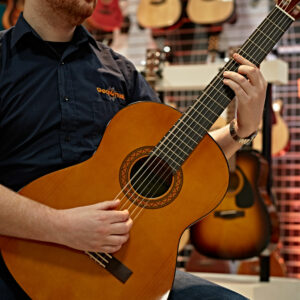
Genres: Classical, Jazz, Folk, Pop
From the graceful melodies of flamenco to the grand compositions of classical orchestras, the classical guitar has earned its reputation for responsive fingerpicking styles and a warm, nylon-string sound.
Typically, classical guitars are smaller in size compared to most other acoustic guitars, resulting in a bright tone that allows individually plucked notes to stand out in a mix. Constructed from various materials, these guitars almost always feature nylon strings. Nylon strings are easier to fret than their steel counterparts, making them less demanding on soft hands that have yet to develop callouses.
Paired with wide, flat radius fretboards, classical guitars facilitate fingerstyle playing by providing ample space for pressing down each note. Moreover, there is a wide range of scaled-down classical guitars available, catering to younger students who may struggle with full-size instruments. This page serves as an excellent starting point for aspiring musicians, offering a variety of smaller instruments suitable for beginners.
While classical guitars can be used for strumming chords and exploring genres beyond classical music, their limited mid-range and low-end punch may make other acoustic guitars more suitable for singer-songwriters.
For those seeking a versatile classical guitar to begin with, the Deluxe Cutaway Classical Electro Guitar by Gear4Music is a recommended choice. This full-size instrument features a cutaway neck for easy access to high frets and integrated electronics for seamless performance and recording.
In summary, the comfortable nylon strings, compact size, and wide, flat fretboard of classical guitars make them an excellent starting point for inexperienced players. Fortunately, there is a wide array of affordable, beginner-friendly instruments available for those embarking on their musical journey.
Steel-string acoustics
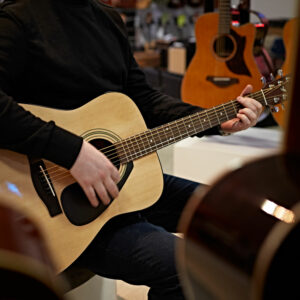
Genres: Classical, Rock, Folk, Country, Pop, Bluegrass, Blues, Jazz
When the term “acoustic” is mentioned, the classic dreadnought style guitar often comes to mind for most people. This association is rooted in the dominance of steel strings in popular music for well over a century, evolving to cater to each new generation of players.
Steel-string acoustic guitars encompass a wide range of shapes and dimensions, significantly influencing the type of sound they produce. The widely recognized dreadnought style, with its larger profile, is renowned for its powerful voice, substantial volume, and distinctive character. Originating from Martin in the 1930s, it has remained one of the most popular choices for six-string enthusiasts. Other shapes include the spacious and chord-friendly jumbo, the slender and bright parlour, and the intermediary-sized concert, larger than a parlour but smaller than a dreadnought.
The tonewoods used in the construction of steel-string acoustics play a crucial role in shaping their sound. Common combinations include mahogany or rosewood for the back and sides paired with a spruce top. Additionally, you may encounter references to solid or laminate woods. Solid wood guitars are generally pricier due to the higher material cost and the fact that their tone improves over time. In contrast, laminate guitars are more affordable and durable, making them ideal for beginners on the go.
The balanced tones of steel-string guitars make them a favorite among singer-songwriters. This versatility allows artists to strum detailed and full-bodied chords while singing over the top. Whether you’re an aspiring artist or a blues enthusiast, the Yamaha F310 serves as an excellent entry point, boasting an impressive voice and the versatility to handle both chords and fingerpicked licks.
Resonator guitars

Genres: Folk, Country, Blues, Bluegrass
Resonators, often overlooked by newcomers to the guitar, carve out a unique sonic niche with their distinctive style and twangy sound. Originating in the 1920s, these instruments with their funky design and metallic construction emerged when traditional wooden acoustic guitars struggled to compete against the horns and percussion of big bands.
In response to this sonic challenge, John Dopyera, an inventive mind, established a company and introduced the first resonator guitar. Setting it apart from conventional acoustics, the resonator employed a metal bridge and “resonator cones” in lieu of a wooden soundboard, resulting in significantly greater volume and a distinctive treble tone.
Following his departure from the initial company, John Dopyera went on to found Dobro, a name that became synonymous with resonators. Today, “Dobro” is often used as a shorthand term for resonators, a term frequently encountered when exploring various models.
Resonators manifest in two primary varieties: round-necked and flat/square-necked. Round-necked resonators can be played like standard acoustic guitars, utilizing the same E tuning but producing an entrancing metallic sound. Conversely, square-necked resonators can only be played flat on the lap due to their neck shape and elevated nut and string action.
Regarding genres, lap steel guitars are predominantly employed for slide playing in country and bluegrass styles. Round neck resonators, on the other hand, are commonly found in country, bluegrass, and blues genres, and their standard guitar action renders them more versatile for branching out into other musical styles.
For those intrigued by resonators, the Hartwood Renaissance Resonator serves as an excellent entry point. Boasting quality features like a bone nut, steel alloy construction, and a biscuit-style resonator, it delivers a sparkling, twangy tone.
Electro-acoustic guitars
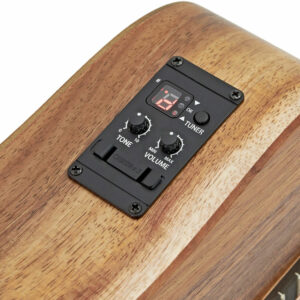
Genres: Classical, Rock, Folk, Country, Pop, Bluegrass, Blues, Jazz
Turn up the volume with electro-acoustic guitars! Essentially identical to standard acoustics but with a crucial addition, these guitars offer the capability to plug into amplifiers for significantly increased volume.
This addresses the challenge of using microphones to amplify acoustic guitars, which can be impractical or cumbersome. Electro-acoustics are particularly well-suited for gigging and recording musicians, providing the convenience of plugging into a PA system, DI, or amplifier to project their sound to a broader audience.
How do they achieve this? Electro-acoustics incorporate a pickup and a preamp to convert the acoustic tone into electronic signals.
The pickup captures the sound of the acoustic guitar, while the preamp enables you to shape your sound using an EQ.
Pickups come in three main varieties, each offering a distinct style of sound:
- Piezo: A strip of magnets beneath the saddle or bridge.
- Microphone: A small microphone mounted inside the guitar.
- Soundhole-mounted: A flat pickup positioned across the soundhole, similar to a solid-body electric guitar.
Most electro-acoustics opt for the piezo style due to its neat, unobtrusive design and lower susceptibility to feedback. As with standard acoustics, the price range for electro-acoustics varies widely, ranging from beginner-friendly models to high-end luthier-crafted instruments with cutting-edge electronics.
This extensive range of available electro-acoustics makes them suitable for players of all skill levels. Many of them also feature onboard tuners, streamlining the tuning process for both beginners and performers.
For those seeking an instrument with a robust voice and user-friendly electronics, the Sigma GJME Grand Jumbo Electro Acoustic is worth exploring. With a jumbo-style body for ample volume and tonal depth, coupled with Sigma’s easy-to-use electronics, it can rock a room whether plugged in or not!
Semi-hollow or hollow-body guitars

Genres: Jazz, Blues, Rock, Pop
Sitting halfway between acoustic and solid-body electric guitars, semi-hollow and fully hollow-body guitars feature large, gracefully curved bodies with resonant sound chambers and electric guitar-style pickups.
Distinctive features shared by both semi-hollow and fully hollow-body guitars include F holes, an archtop body, and adjustable tailpieces.
Semi-hollow vs. Hollow-body
Hollow-body instruments are nearly entirely hollow, delivering expansive, full-bodied tones with exceptional clarity and a rich acoustic character. This characteristic makes them particularly well-suited for clean jazz and blues genres.
However, fully hollow bodies can face feedback issues at higher volumes, potentially distorting or compromising their pristine sound. The semi-hollow design addresses this concern by incorporating a center block running through the middle, effectively canceling out feedback. This design allows semi-hollow guitars to achieve higher levels of gain, suitable for producing crunchy and distorted tones.
As a result, the sonically versatile semi-hollow design has become more popular, adapting well to modern rock, blues, and pop while maintaining a clearer sound. BB King’s Lucille ES-355 stands out as one of the most iconic archtop semi-hollow guitars, so iconic that it has been stolen several times!
In the fully hollow category, John Lennon’s Epiphone Casino remains one of the most sought-after models, featuring a thinline construction to reduce feedback and boasting an utterly distinctive style.
For those intrigued by the archtop aesthetic and rich tonality, the Epiphone ES-339 serves as an excellent starting point. With its semi-hollow construction and powerful humbucker pickups, it offers clarity for clean jazz, classic crunch for blues, and higher output capability for rock ‘n’ roll.
Solid body electric guitars
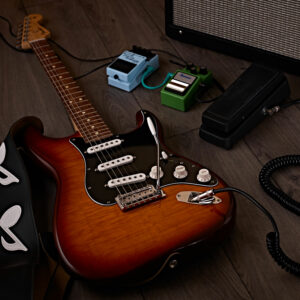
Genres: Rock, Country, Metal, Blues, Jazz, Pop, Electronica
Representative of 20th-century music, solid-body electric guitars are synonymous with what most people identify as “rock.”
From Jimi Hendrix in the ’60s to the virtuosic Polyphia of today, solid-body electrics have been wielded by generations of famous artists. These musicians not only played them but also pushed the boundaries of genres to the extent that electric guitars are now integral to many modern forms of music.
In contrast to acoustics and hollow-body electrics, solid-body electrics rely heavily on pickups for their tone. These block-like magnets cover each string and come in various varieties, significantly influencing the type of tone you can expect.
In addition to pickups, the neck shape varies depending on the type of guitar. Shredder guitars, designed for fast-paced metal enthusiasts, feature super-thin necks for speedy solos, while larger jazz instruments have thicker necks for easier chording.
When it comes to sounds, the possibilities are limitless! Since solid-body electrics produce an electric signal, you can easily modify your tone with effect pedals to achieve anything from gentle overdrives to completely otherworldly digital delays and reverbs.
The Fender Stratocaster stands out as one of the most famous guitars in existence, and the Vintera ’60s model captures the essence of the earliest versions. With a cool period appearance and sparkling, glassy tones, this guitar is quintessential for rock, blues, and beyond.
Bass guitars
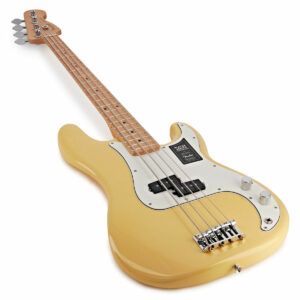
Take an electric guitar, elongate it a bit, and string it with much thicker strings, and you’ve got yourself a bass! The electric bass guitar, invented by Leo Fender in the ’50s, addressed the challenge of the acoustic double bass being drowned out in a band setting.
While acoustic basses are still in use, particularly in jazz or stripped-back acoustic pop, electric basses have become the predominant choice due to their increased flexibility in both playing technique and tonal possibilities.
Similar to electric guitars, electric basses are equipped with pickups to capture and shape the sound. These pickups range from lower-output vintage-style ones to thicker, high-output humbuckers that produce crunchier and more aggressive harmonics.
For those who see themselves as rhythm machines, the bass could be the perfect calling! Typically providing the low-end foundation in the background, bassists play a crucial role in adding heft and body to a piece of music. However, with funky slap styles, modern bassists often take on a lead role in ensembles as well.
The Fender Player Precision Bass, often referred to as a ‘P bass,’ stands out as one of the most iconic 4-string instruments. Easy to play with its single split-coil pickup, this buttercream bass can handle a variety of classic genres, from disco to indie rock, making it a great all-rounder choice.
For those seeking a bass with a bit more thump for heavier styles, the Ibanez SRMD200D features two pickups for extended frequencies and a more affordable price point, making it an excellent option for newer players looking for their first bass!
7-string guitars
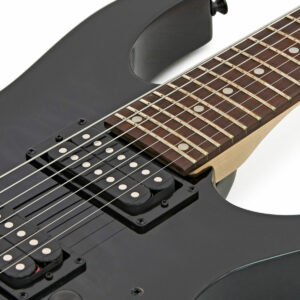
Genres: Metal, metal, and more metal. Also jazz and jazz fusion occasionally
Expand your sonic range with 7-string guitars, featuring an additional low B string that broadens the spectrum of available frequencies. This extra string allows you to delve into thunderous bass-y depths, making 7-string guitars particularly well-suited for heavy genres like metal.
In these heavy styles, which often rely on dark tones and powerful rhythms, the added low end enhances the menace of ferocious chugs. Beyond metal, genres like jazz and jazz fusion can also benefit from the wider sonic range of the 7-string, enabling the creation of interesting chord shapes and richer bass rhythms.
7-string guitars designed with metal in mind typically feature sleek bodies equipped with humbucking pickups. Additionally, they often have thin, slender necks to accommodate the extra string. Extended-range guitars, those with more than 6 strings, often incorporate multi-scale fretboards where the frets are slanted instead of straight. This design allows your hand to rest in a more natural position for executing quick and speedy solos.
But does the innovation stop at 7 strings? No! There are also 8 and 9-string guitars available for those seeking even lower tones. These instruments are usually reserved for super technical virtuoso players, appealing to those who love pushing the boundaries of musical complexity.
If you’re looking for a 7-string to get started, the Ibanez GRG7221QA GIO is a robust, well-crafted instrument with powerful, metal-ready pickups. Featuring a string-thru bridge for tuning stability and a 5-way selector for a wide range of tones, it’s an excellent choice for budding metalheads.
12-string acoustics
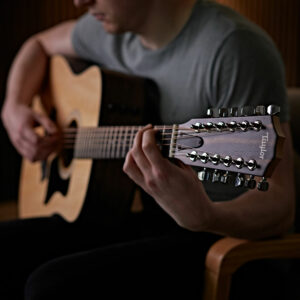
Genres: Folk, Country, Blues, Rock
Producing a sparkling and beautiful octaval sound, 12-string acoustics have played a pivotal role in some truly iconic songs. Tracks like “Hotel California,” “A Horse with No Name,” and “Wanted Dead or Alive” feature the distinct sound of the dozen-stringed instrument.
But why opt for double the number of strings? Is it excessive? Not at all, as the strings on a 12-string guitar are arranged in pairs, treating each couple as one string. This means your playing technique remains the same, but the sound is transformed because each additional string is tuned an octave apart in pitch.
This arrangement creates a sweet, dynamically rich effect that can turn even basic chords into majestically sweeping sounds. So, why aren’t 12-strings recommended for beginners? The wider and fatter neck required to accommodate the extra strings and tension can be challenging for players who haven’t yet developed the strength in their fretting hand.
Additionally, maintenance tasks are doubled – you have twelve strings to replace with each restringing instead of six. The significant change in tension often necessitates adjustments to the neck to maintain consistent playing action.
Despite these challenges, if the allure of the harmonically lush 12-string captivates you, the Fender CD-140SCE is an enticing option. This guitar offers an entrancing sound without being overly expensive, featuring a cutaway body for easy access to the upper frets and built-in electronics to simplify recording and live performances.
Ukulele
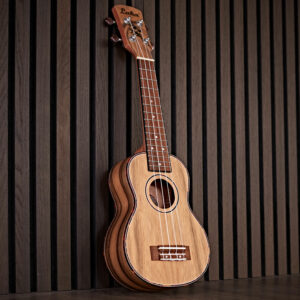
Genres: Pop, Rock, Jazz, Blues
Small, sonically bright, and incredibly enjoyable to play, the ukulele welcomes musicians of all levels, from novices to professional guitarists. Coming in various shapes and sizes, the ukulele typically features a small guitar shape, four strings, and a lively treble sound.
Originating in Europe but strongly associated with the Pacific paradise of Hawaii, the ukulele has become a symbol of white sand beaches, crystal blue ocean waters, and lazy afternoon luaus. It has experienced a resurgence in popularity due to its affordability, ease of playability, and social media potential.
While not invented in Hawaii, the ukulele was adopted and embraced by the locals after being introduced by a traveling Portuguese musician. Impressed by the small guitar’s rapid playability, they named it ukulele, which translates to “jumping flea.” The instrument gained such popularity that even the Hawaiian monarch learned to play.
In terms of construction, ukuleles are built much like scaled-down acoustic guitars, featuring a variety of tonewoods. Cheaper ukes may have laminate or plastic construction, while more expensive models boast solid woods. The shape of the ukulele can also vary to produce different sounds. Soprano ukuleles, the most common, have a super bright voice. Concert styles, a bit larger, tend to have a darker tone. Tenor ukes have a longer scale length and use a tuning similar to guitars, while baritones have an even longer scale length for an extended bass range.
Ukuleles are excellent for beginners due to their low cost, simplicity, and sing-along potential. The Luna Vintage Concert Uke, larger than a soprano, provides a few more tonal options and features built-in electronics for taking that gentle, treble-rich voice to the stage and beyond.
Weird electrics
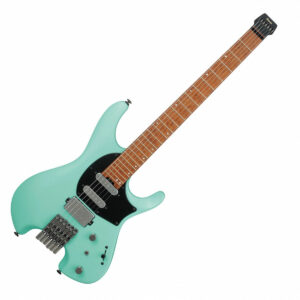
Genres: Classic Rock, all kinds of metal, jazz, heavier metal, jazz fusion, and did we mention metal?
When we talk about weird guitars, we’re referring to instruments that deviate from the standard six-string layout, offering unique features and designs. Some examples include:
- Double-necked Guitars: Popularized by Led Zeppelin guitarist Jimmy Page, these guitars combine a 12-string and a normal 6-string into a single instrument. This fusion provides both an enveloping octaval charm and a standard electric guitar chop simultaneously. However, they tend to be heavy and cumbersome to play.
- Extended Range & Multi-scales: These guitars, building on the concept of 7-strings, provide more low-end frequencies for exploration. They are favored by musicians in heavy styles and creative virtuosos seeking to maximize the fretboard’s potential.
- Headless Guitars: Examples like the Ibanez Q series feature a design where the headstock is eliminated. While they may look unconventional, this design choice has musical benefits. It replaces the traditional ‘nut’ with a ‘zero fret,’ ensuring all notes are fretted, similar to playing with a capo. This results in smooth transitions from open to fretted notes, more even string tension, improved intonation accuracy, easier string changes, and reduced size and weight.
- Baritone Guitars: Suited for lower tunings, baritone guitars have a longer scale length that helps maintain string tension when tuned to deeper pitches. Ideal for heavy styles that favor drop tunings, they are not limited to one genre. Baritone electrics find applications in surf rock, country, jazz, and more, featuring various shapes and styles.
Each of these oddities serves a specific musical purpose, showcasing interesting and distinctive designs to achieve their unique sounds.
More acoustics
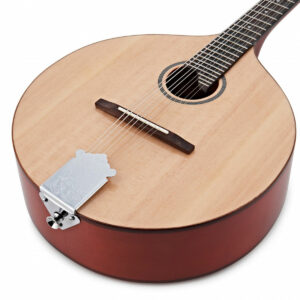
Genres: Country, Folk, Bluegrass, Blues, Classical
Completing our guide to guitar types, let’s explore a selection of acoustic instruments that often fall into the “folk” category:
- Mandolin: Compact and small, mandolins feature paired strings similar to a 12-string acoustic guitar. With four pairs of strings and a small sound chamber, mandolins produce a bright, treble-focused voice that easily cuts through a mix.
- Banjo: Instantly associated with country music, banjos have a sweet, jangly tone and are capable of rapid riffing. Despite their country roots, banjos cover a broad range of genres, from Dixieland jazz to modern rock.
- Harp Guitar: A unique instrument that fuses a harp and a nylon-stringed acoustic guitar, offering an extended frequency range. Harp guitars produce sweet, mellow tones and create beautiful soundscapes, making them ideal for adventurous players.
- Lap Steel/Pedal Steel Guitars: These guitars provide an alternative way of playing strings. Lap steels are small, compact instruments meant to be played on your lap, using a slide or flatpick. Pedal steels, on the other hand, are mounted on dedicated tables and feature small levers that allow you to change the pitch of strings while playing. This design opens up a vast variety of sonic possibilities to explore.
Each of these folk instruments produces a distinct sound, making them appealing choices for guitarists interested in exploring specific tones and genres.
Selecting the Perfect Style for Your Needs
With the plethora of guitar types we’ve covered, it’s natural to feel a bit overwhelmed. The good news is that the beauty of learning an instrument lies in the diverse options available. Even if one type doesn’t resonate with you, there are plenty more avenues to explore. If a large acoustic guitar doesn’t suit your taste, you might find joy in the slinky, rock-focused world of electric guitars!
To determine your ideal instrument, start by listening to your preferred music and identifying the key sounds. If you’re into hard rock, blues, or other distortion-rich genres, an electric guitar is likely your perfect starting point. If you love bluegrass, country, or the lively tones of the banjo, give it a try! Many banjo players have never touched a standard guitar.
Ensure that the chosen guitar type matches both the sound and design of your preferred genre. Trying to shred solos on a steel-string acoustic may prove challenging due to factors like neck shape, body size, and string material affecting speed and action.
When it comes to acoustics, the choice between acoustic and electro-acoustic depends on your budget and needs. In general, opting for an electro-acoustic is a wise decision, as it provides broader performing and recording capabilities, allowing you to do more with the guitar.
In summary, the type of guitar that’s right for you ultimately depends on your preferred sound and the genre you’re most passionate about.

Frequently Asked Questions (FAQs)
We’ve collected some common questions about guitar types and answered the top queries.
Exploring the Four Primary Categories of Guitars
The four main types of guitars that are widely recognized and popular are:
- Acoustic Steel-String Guitars: Known for their versatility, these guitars have steel strings and are often used in various genres, including folk, rock, pop, and more. They come in different body shapes, such as dreadnought, concert, and jumbo.
- Classical Guitars: Recognized for their nylon strings, classical guitars are commonly used in classical, flamenco, and traditional styles of music. They typically have a wider neck and a mellow, warm tone.
- Electric Guitars: Designed to be amplified, electric guitars use magnetic pickups to convert string vibrations into an electric signal. They are essential in genres like rock, blues, jazz, and many others. Electric guitars come in various shapes and styles, each contributing to different tones.
- Bass Guitars: Larger and lower in pitch than electric guitars, bass guitars are crucial for providing the low-end foundation in many music genres, including rock, funk, jazz, and more.
Most Popular Types of Guitars in Common Use
Acoustic guitars hold the title of the most commonly utilized guitars. They are adaptable to various playing techniques, offering a versatile sound, and do not necessitate any supplementary equipment like amplifiers to operate. Furthermore, they excel as solo instruments alongside vocals and seamlessly integrate into larger ensembles.
Choosing the Ideal Guitar for Beginners
A classical guitar stands out as an excellent choice for beginners. Its compact size, gentle nylon strings, and absence of additional equipment make it well-suited for those just starting out. The flat fretboards of classical guitars contribute to the development of fingerpicking skills and picking accuracy, further enhancing their suitability for novice players.
Final thoughts
I trust this comprehensive article has ignited your curiosity to explore a new stringed instrument. For those starting their musical journey, peruse our extensive collection of acoustic and electric guitars to kickstart your experience.
For those seeking to make a distinctive statement, consider our bold extended-range guitars, sophisticated 12-string acoustics, or the vibrant and lively world of ukuleles.
The diverse array of guitar types accommodates every style and preference. As highlighted in this article, if you ever find yourself craving variety, there are plenty more types to experiment with!
Wishing you joyful playing!
21 Simple Christmas Guitar Songs to Enjoy This Winter
27 Easy Guitar Songs for Beginners
The Top 11 Electric Guitar Brands Ever